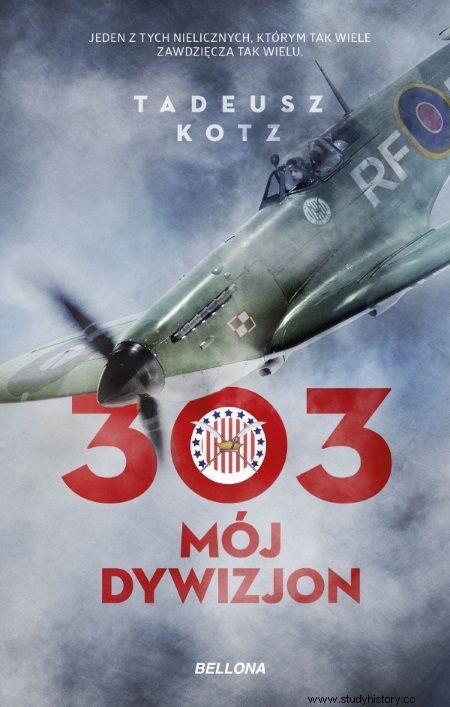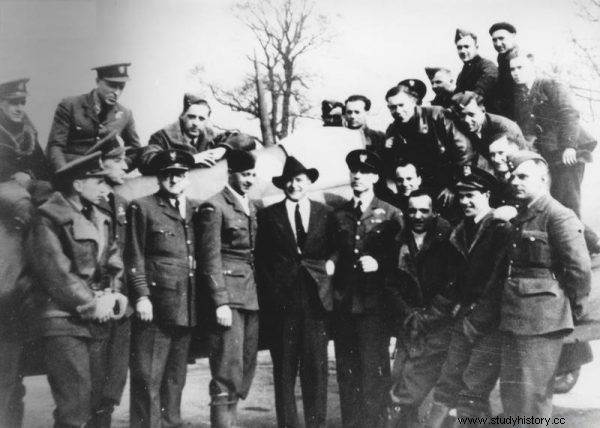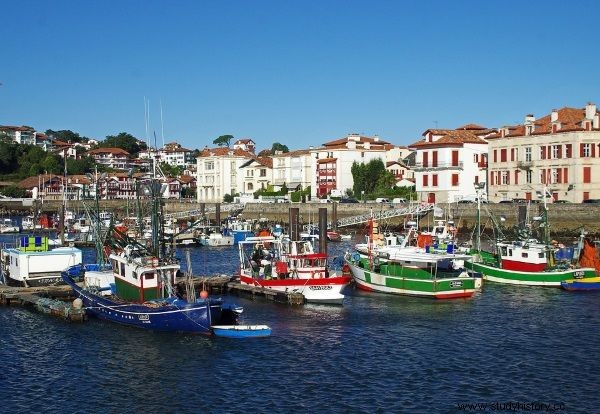He flew night and day, hunting and covering bombers. He has seen his colleagues die more than once. When he set off on the unlucky mission, he did not expect that this time his plane would be hit by enemy bullets. How did he manage to travel thousands of kilometers and return to base?
The alarm that sounded at the British airbase on February 3, 1943 was supposed to mean another routine flight for Tadeusz Kotz. More than once, he and other pilots traveled over occupied Europe, attacking German targets, fighting Luftwaffe pilots or escorting bombers carrying deadly payloads. As he himself recalled years later, he had been tormented by sleep for some time. It also started with an alarm and a flight towards France. Then the action was fast:
We pass the English Channel, reach St. Omer and encounter a swarm of German fighters. A fierce fight begins. My luck is over:the German got me. My plane is hit by a 20mm cannon, it smells like a torch. I jump out on a parachute and terrified of a difficult situation, all sweaty with fear… wake up from sleep. Endless feeling of relief:how good it was just a dream.
Prophetic dream?
On February 3, 1943, Polish pilots also flew over St. Omer, where they entered an aerial skirmish with the Germans. The airmen were once a cat chasing Messerschmitt, only to become a mouse after a few clever maneuvers of the enemy. During this fatal "tag", Kotz noticed that his plane was hit and the glycol that cooled the engine ignited. His nightmare began to come true. If he wanted to save a life, he had to jump out immediately before the fuel caught fire. He started unbuckling his seat belts, his brain working like a programmed mechanism.

Location of Polish air squadrons during the Battle of Britain (photo:Lonio1, license CC BY-SA 4.0)
Accustomed to what he always did after the flight, he unhooked himself from the chair, and then ... he also disconnected the straps holding his parachute. Fortunately, at the last moment he realized what had happened and refastened his harness. When the plane was on fire, it jumped out. He counted three seconds to keep his parachute from hitting the machine and reached towards the handle that… wasn't there. As Kotz recalls in the recently reissued diary entitled "303. My Division ":
The hand was nervously looking higher, lower, right, left - in vain! I started at five thousand meters, I go down like a rock. Sharp urgent awareness:look for the handle or death! I tried to tear open the parachute cover, it failed.
In the meantime, the pilot's entire life passed before his eyes. As he approached the ground, he frantically felt all the nooks and crannies. Finally, he managed to feel the handle, yanked it and the parachute canopy opened ... about 200 meters from the ground. Absolutely last minute. When he landed, he concealed his parachute and life jacket, and then dashed towards the buildings a kilometer away. He ran into the barn, where the farmer was flailing peas with his flail, grabbed some sacks and ran to the garden, wanting to hide in it.
In the sandy ground he found a shelter under the bushes in which he hid himself. Just in case, he checked that he had no "hot" documents with him and destroyed some papers.

Memoirs of Tadeusz Kotz "303. My Division " have just been released by Bellona
Potato seal
As it turns out, the host must have been well aware of the uninvited guest. At dusk a young Frenchman appeared next to Kotz's hideout, threw him something to eat and said that he would come for him later. After dark, he returned and took him to his home, where the officer was warmly received. The French even helped him buy civilian clothes (a suit and shoes), and then led him to a hideout in his attic, where the Polish pilot was supposed to sleep.
Soon a German patrol arrived in the yard looking for the downed aviator. The Germans began a search, to be sure they jabbed the straw with their bayonets. Although it was close, they did not find Kotz. During the night they repeated the visit, again without success.
The next day the pilot had to change the hideout. A miller took it over less than 10 kilometers away. Kotz was placed in a barn with fresh bedding waiting for him, fed and allowed to rest. The next day, he was re-fed solidly, and in the evening the miller made for him… a French ID card. Kotz had a photo with him, his guardian, on the other hand, brought a blank ID card from somewhere, in which they entered the relevant data together, and later, as Kotz himself states, I also learned from a miller to forge stamps with a potato imprint .

303 Squadron pilots, commanded by Kotz, during Marian C. Cooper's visit (in a suit). who commanded the 7th squadron in the Polish-Bolshevik war.
Then, in the morning, together with the French, he set off to a nearby town with a railway station. The biggest obstacle was not the German patrols, not the threat of arrest or the language barrier, but too tight shoes. The footwear he had bought the first evening from the young French was much too tight, so as time went on, he felt more and more pain with each step. Before the town he said goodbye to his guardians and went on alone.
He reached the station where he was to take the train to Paris in the morning. He had to find accommodation in the French capital, because after the curfew he could not wander the streets. After several unsuccessful attempts, he remembered his Polish friend.
He directed his steps to the restaurant where he had been during his previous stay in Paris (after the war broke out, he flew in France). Kotz ate a meal there and was given a piece of information worth its weight in gold - the address of Miss Stasi, who he hoped would agree to spend the night. As it turned out, his friend was not at home, and time was running out. Eventually, he found himself in the back of a small hotel, where he was to share the hideout with a certain Jew for an appropriate fee paid in advance.
With a girl at the cinema
The next day he ran towards Stasi's apartment. When he greeted her by name, the woman was startled. It turned out that she completely did not remember him. Kotz saved himself by reminding himself of his much more handsome friend and the fact that they were together in the cinema. This refreshed the woman's memory and let him into the house. Moreover, she gave the aviator breakfast and, at his request, went to buy him a ticket for the train going south.

St. Jean-de-Luz looks like this today. It is hard to believe that the Polish pilot experienced moments of terror there. (photo:DEZALB, CC0 license)
Kotz's plan was to make his way through the Pyrenees to Spain and then through Gibraltar to reach England and continue fighting. Before he hit the road, his friend took him shopping, they went together to lunch and to the cinema for a movie about love.
Were it not for the fact that the show was interrupted every now and then by German propaganda news, Kotz might even have believed that there was no war around. In the evening he said goodbye to his companion and got on the train. While driving, he often alternated between sleeping and pretending that he was doing it in order not to draw attention to himself. During one of the simulated naps, he overheard the conversation of his fellow passengers. As he describes it in his memoirs entitled "303. My Division ":
And you know - one began - there have been several cases of shot down English pilots escaping to Spain. Twenty kilos east of St. Jean-de-Luz is a bridge across the Irun River, on which there are rarely inspections because it is not often visited. After crossing the bridge, you go on through the Pyrenees and during the night you are on the other side of the border.
Although after reaching St. Jean-de-Luz approached the passport control with his soul on his shoulder, he managed to pass it without any problems. Kotz, however, felt that he could not stay in the city because it was too dangerous. Wandering towards the border with Spain, he finally found the aforementioned bridge, which was guarded by one German soldier. The Polish pilot mingled with the crowd of villagers and passed by unnoticed.
Only later did his luck turn away from him and on the other side of the river no one stayed overnight, so he decided to cross the mountains at night, guided by the stars.

The President of the Republic of Poland, Władysław Raczkiewicz, decorates Lt. Koc (photo:press materials of the Bellona publishing house)
He struggled through bushes, slopes, and swamps, feeling the chills from the cold. Each climb up seemed his last, and he regretted to find that he was going to climb again. The hike was not only a physical burden. At times Kotz moved only by willpower. Finally he made his way to the bank of the river, where he came across the Spaniard, rifle in hand, who began shouting at him. Kotz, in order not to earn a ball, ran towards the bushes, and then began descending the mountains towards the shimmering lights of the town in the distance. Luck turned away from him again.
When he came across a group of policemen with rifles, he escaped. Adrenaline gave him so much strength that he managed to escape despite his exhaustion, and then he made a detour from the town. It turned out that, contrary to his predictions, the British consulate was not there. He had to move on and travel another 30 kilometers. As he describes it in the book "303. My Squadron ”, when he finally reached San Sebastian:
I found the consulate without difficulty. Two Spanish sentries with rifles stood in front of the large door. "What to do here - I think - they may not let them in, and if they catch, they will send it to the Miranda camp, where, after being tortured, they normally starve to the sea." Such were the rumors about order in Spain. I was waiting for the changing of the guard. Within twenty minutes a group of four new sentries arrived.
Kotz ran between them and ran towards the consulate upstairs. The sentries followed him, but when he slammed the facility door behind him, he was safe. He could go back to England.
Source:
- Memoirs of Tadeusz Kotz "303. My Division ”, which have just been released by the Bellona publishing house.
Read the memoirs of the 303 Squadron commander:

